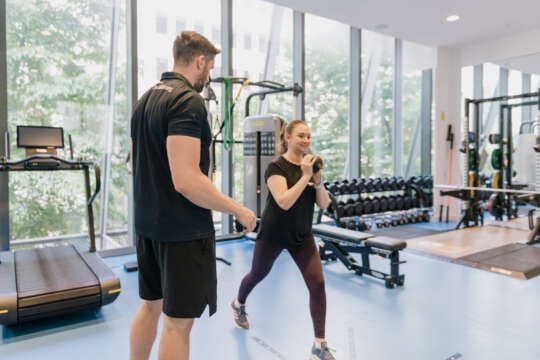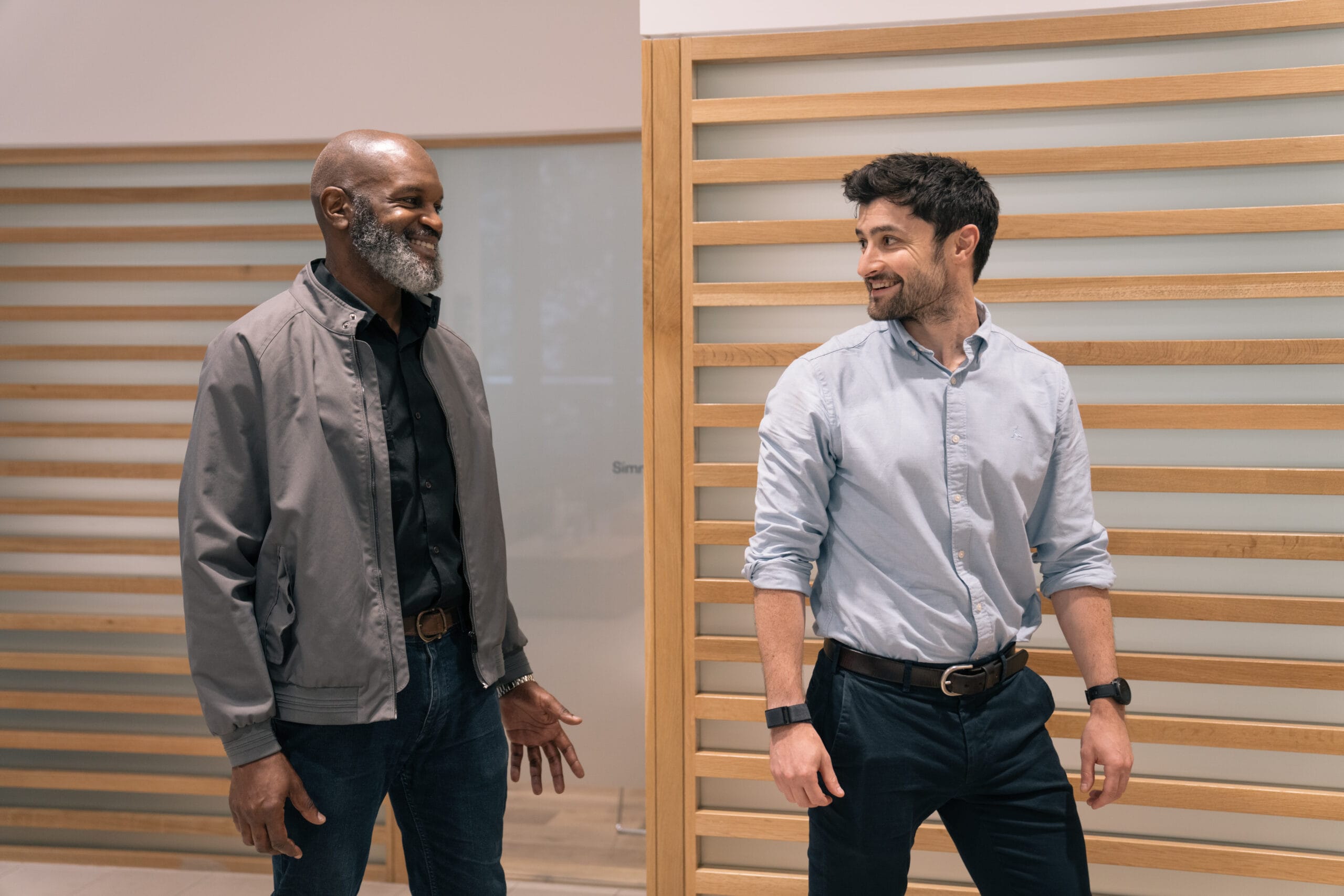The Benefits of Squats for Strength, Mobility, and Health

Pure Sports Medicine
- 13 July, 2021
- Exercise
- Podiatry
- 7 min read
Here’s the thing, too much of anything can be bad for you. Everything in moderation is a much more intuitive way to get strong and stay healthy.

Working in elite sports I often come across coaches and athletes who either swear by the squat or despise the squat. It’s a bit like marmite. Here’s a few reasons why I prescribe some variation of squatting to almost everybody.
Strength and Hypertrophy (muscle growth)
Glutes: Combined, the gluteus maximus and medius make up the largest muscle in the human body, responsible for a large portion of our power production. You can strengthen the glutes by squatting — which is important considering that stronger glutes aid in lower body strength and stability. (1)
Quads: The four quad muscles — vastus medialis, vastus lateralis, vastus intermedius, and rectus femoris — support leg extension and protect the knee from instability. Also, research suggests that fuller ranges of motion can elicit significant quad growth at lower intensities. Simply put, you don’t always need to squat heavy to build mass, but you do need to squat in the full range of motion. (2)
Hamstrings: Made up of the semitendinosus, semimembranosus, and biceps femoris, the hamstrings flex the leg during exercise and when walking, jogging, and running. The hamstrings also play a large role in our jumping abilities.
Calves: Your calves are made up of the gastrocnemius and the soleus. These muscles help us move faster (through plantar flexion), improve ankle stability, and support proper lower extremity mechanics. Strong calves also increase our ankle strength and improve our ability to generate and absorb power through the ground when jumping, lifting, and running.
Squatting can put our calves through more ranges of motion than static calf exercises can. One study concluded that limitations in plantar flexion (pushing your toes into the floor during squats) led to knee valgus, a common issue in which the knees collapse inwards, resulting in excessive stress at the knee joint. (3)
Trunk: In this scenario, we’re referencing the whole torso as the core, not just the abs. When you’re holding weight and moving through multiple planes of motion, the body must work hard to remain stable and not fall over. This, in return, strengthens the core as a whole, which includes the lower back, inner spinal stabilisers, mid-back, obliques, and abdominal musculature. (4)
Mobility, Joint Health and Stability
Mobility: Mobility isn’t just about your range of motion, but how strong you are in specific ranges of motion. Squats improve your ability to, well, squat. Repeatedly performing squats trains your joints to move through Squats through multiple planes of motion. Adding weight to your squats over time will result in strength at both the bottom and top of a squat. That newfound squat strength carries over to everyday life. (5)
Joint Health: When it comes to the function of your joints, if you don’t use them, you do lose them. However, when you regularly squat, you strengthen and build the muscles, bones, tendons, and ligaments that make up our joints involved in squats. (6)
Stability & Posture: When you improve your core strength and lower extremities, you improve your posture. Posture is influenced by both anterior (front) and posterior (back) muscles, creating a healthier body. When performed with proper form, squats can improve our hip health by combating things like the act of sitting all day (don’t forget to stretch and mobilise). Squats also build our torso strength to prevent things like internal rotation of the shoulders and kyphosis (hunchback). It’s important to note that stretching and mobilising are also keys to improved posture, not just squatting.
Power
Squats improve our ability to jump. How? Since we’re strengthening all of the lower extremities, we’re increasing our ability to produce power (stronger and better-conditioned muscle equals better power output).
A study published by Hartmann et al (2012) analysed 59 participants and their vertical jump while following a ten-week program that focused on three squat variations: front squat, back squat, and partial squat. The results? Deep full squats improve vertical jump by increasing the ability to develop force.
They also increase our ability to produce power when done explosively, such as in the jump squat. (7) Leg extension, flexion, and hip extension are all key players when we’re sprinting, absorbing force (landing of jumps and braking in a sprint), jumping, and moving weight. You won’t gain power by ignoring the largest part of your body, aka, the lower extremities (legs).
Hormone Production & Fat Loss
Squats have been shown to improve our natural hormone production, mainly testosterone and growth hormone. (8) While studies are still conflicted about the reasoning behind this, there’s a hypothesis that generally agrees. It’s most likely a reaction to the stress of highly demanding movements and forces, such as free weights.
Injury Prevention
A majority of – but not all – injuries when moving can be linked to imbalances and weaknesses. The squat improves knee and hip stability, which can help remedy a lot of issues associated with imbalances. (9) Along with fixing imbalances and weaknesses, the squat can be a great tool for assessing deficits we may experience when lifting (basically, using proper form to perform a movement diagnosis). (10)
Back Squats: involve the bar being loaded across the back of a lifter (usually from squat stands) before said lifter takes a deep breath, curses his existence and squats down to the ground, and stands back up. It is one of the most commonly performed exercises in any gym, and for good reason. Honestly, nothing would give you greater bang for your buck than a Back Squat!
Front Squats: on the other hand, are a little bit more elusive. Loading the bar across the front deltoids results in a very different, but similar movement to the back squat. It also means that technically, you are forced to lift less, keep strict form, and always have a tough time breathing if you’ve got more than 5 reps.
There are many different ways that people squat. In the end, any given person’s squat position is dictated by their proportions, weaknesses/strengths, flexibility, and intent.
Biomechanics 101
Now, although I studied Biomechanics at university, I am definitely not an expert on the subject, so bear with me here. The above picture is a good illustration of various squatting positions. One important thing to note is that the bar is always in line with the midfoot. This is essential to any good squat, as any heavyweight must be lifted through the natural area of balance (i.e. the feet for humans).
Think about it, have you ever tried squatting a weight such that the bar is far out in front of your toes? Well, it’s impossible. To accommodate this “centralness” and the centre of gravity of the bar-human system, the torso will lean to a different degree, and the hips will change their distance from the ankles. Because the bar will at some point be heavy, pushing the centre of gravity (of the system) up the torso, the natural tendency is for it to pull the athlete forward. In accordance with the first law stated above about mid-feet, this usually means that the hips must shoot back (hard to balance), which is undesirable (albeit often unavoidable) for any application.
As is evident in the above illustration, a good Front Squat requires a very upright torso and somewhat good mobility. For weightlifting intents, this is a very desirable position. Like any other squat, the exact degree of lean of the torso will depend on limb proportions and flexibility.
In the end, the body will naturally obey the law of centralising the weight and lean the torso over according to how far back the hips are. However, since the bar is in front of the body (and also because it may just drop out of your hands if you lean over too much), any athlete will be more upright in a Front Squat than Back (Remember, the weight must stay over midfoot, and the back will be at an angle to accommodate this. With the bar in front, less torso lean is required to maintain the position).
Our intention is to minimise the torso lean and squat in a way that the hips are as close to the ankles as possible, thus achieving the desired upright torso. It provides great stability and allows the load to be taken by strong trunk musculature and legs as opposed to the lower back and hips.
On the other hand, this means that most athletes, especially those with weak abs, quads, glutes, and bad mobility, have a tough time squatting from this position. But then, many athletes (especially in sports like Powerlifting) prefer a type of squat that results in lots of forward lean, with the hips far back and the shins vertical. This makes sense for their application. Greater torso lean usually results in better activation of the powerful posterior chain, combined with cutting depth, massive weights can be moved using this method of squatting; otherwise known as low-bar squatting. I have very little experience when it comes to training and coaching low bar, so I will not be going into the biomechanics of that lift. Let’s just cut it short and say it’s different, balance is different, loading is different, etc.
Potential Downside
Squatting is very tiring. It is exceptionally fatiguing and requires immense energy. Any given person only has so much energy and time to spend and must utilise all they have to the best of their ability to improve other areas of their fitness, health and performance. It is easy to get caught up in improving squat numbers and looking strong with big plates on the bar, but one must remember that the end goal is an improvement of the movement pattern. It’s very much the same as driving when you’re tired, you aren’t focused, and it’s probably not a good idea. The same principle applies.
When should I do Squats?
Generally, the structure of the session would dictate that squats should be done as close to the end of the warm-up as possible to ensure that correct movement and proper positions are upheld. As this movement is complex and drives force production through the lower body then it makes sense that this exercise is performed near the start of your training session.
What variation can I do?
We have already covered the back & front squat, but here are some bilateral variations of the squats that I have included in training programmes in the past, such as:
- TRX Squat/ Bodyweight Squat
- Goblet Squat
- Pause back/front squat
- Tempo back/front squat
- Overhead squat
- Box squat
- Pin squat
- Safety bar squat
- 1/2 squat
- 1/4 squat
- 1 & 1/2 squat
- Squat jump
- Cyclist squat
- Gakk squat
- Anderson squat
- Zercher squat
- And if you want to count them – Split squat, Rear foot elevated split squat and front foot elevated split squat.
In summary, you can never go wrong with loading up a bar, getting underneath it, sitting down, and standing back up again repeatedly to make those legs strong and your lower body more mobile.
If you are unsure where to get started or how this type of training could help you in your fitness, rehab, health or performance journey, then get in touch with one of our Strength and Conditioning Coaches who can answer any questions you may have.
References:
- Esformes, J. I., & Bampouras, T. M. (2013).
- Bryanton, M. A., Kennedy, M. D., Carey, J. P., & Chiu, L. Z. (2012).
- Macrum, E., Bell, D. R., Boling, M., Lewek, M., & Padua, D. (2012).
- Aspe, R. R., & Swinton, P. A. (2014).
- Myer, G et al. (2014)
- Adams, O’Shea (1999).
- Baker, D., Nance, S., & Moore, M. (2001).
- Shaner et al (2014)
- Shaner et al (2014)
- Escamilla R. F. (2001).

Advice
Over the last 20+ years our experts have helped more than 100,000 patients, but we don’t stop there. We also like to share our knowledge and insight to help people lead healthier lives, and here you will find our extensive library of advice on a variety of topics to help you do the same.
OUR ADVICE HUBS See all Advice Hubs

